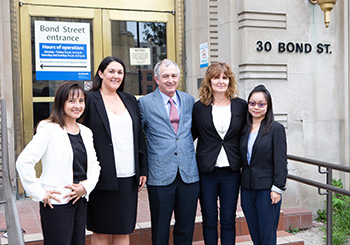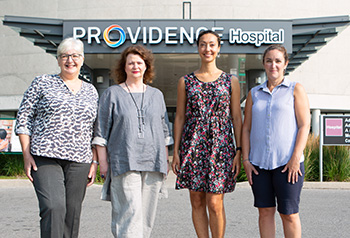A new St. Michael’s-Providence initiative is tackling painful wait times

By Selma Al-Samarrai and Michael Oliveira
Trevor Kampen is the first patient to take part in the new St. Michael’s-Providence clinical collaboration that could eventually help double the number of pressure wound surgeries performed at St. Michael’s each year. Providence staff have enhanced knowledge to provide rehabilitation for patients who undergo the surgery.
Trevor Kampen marvels at the number of people he’s met during his journey from St. Michael’s Hospital to Providence Healthcare to treat his debilitating pressure wound, a condition caused by his spina bifida.
“There’s a lot of people involved in this,” the 30-year-old says with a chuckle as he tries to list off the names of all the doctors, nurses, occupational therapists, physiotherapists, his dietician and others who have had a part in his care.
“If I forget somebody, I’m sorry, but there’s a lot of names and faces to remember.”
Kampen is the first patient to take part in the new St. Michael’s-Providence clinical collaboration that could eventually help double the number of pressure wound surgeries performed at St. Michael’s each year. Pressure wounds are caused by prolonged or intense pressure to a localized area, and often develop in individuals with impairments in sensation or motor function.
Providence staff have enhanced knowledge to provide rehabilitation for patients who undergo the surgery.
“To be a part of this new initiative and be able to provide a service in such a meaningful and important surgery is very exciting,” says Providence patient care manager Chiara Campitelli-Thompson.
“It may sound a little cliché but this has been the true definition of collaboration.”
Previously, it was a struggle to find facilities that could take on a patient for the typical six-to-eight weeks of post-operative recovery time, says Dr. James Mahoney, chief of Plastic Surgery, who performs the surgeries along with Dr. Karen Cross.
“I had actually stopped doing the surgery for more than a year because I did not have the rehab space to provide patients the support I thought they required,” Dr. Mahoney says.
“The surgery is only one little part,” he adds, stressing how important the collaborative nature of the initiative is. “My surgery can be undone in one episode if something is not done correctly in the rehab process.”

The care team at St. Michael’s Hospital (from L to R): Janeth Velandia, nurse practitioner, Wound Care Team, Dr. Karen Cross, plastic, reconstructive and aesthetic surgeon, Dr. James Mahoney, chief division of Plastic and Reconstructive Surgery, Elizabeth Butorac, program director, Trauma/Neurosurgery and Mobility programs, and Cecilia (Ting-Ting) Wan, occupational therapist, Wound Care Team

The care team at Providence Healthcare (from L to R): Susan Chandler, clinical nurse specialist in wound care & prevention, Kimberly Mackenzie, relationships and partnerships manager, Chiara Campitelli-Thompson, patient care manager, and Kelly Tough, patient flow manager.
Collaborating with Providence as the rehabilitation site means patients have access to the interdisciplinary care needed for a healthy recovery, explained Janeth Velandia, nurse practitioner for the Wound Care Team at St. Michael’s Hospital, and one of three project leads for this clinical collaboration along with Cecilia (Ting-Ting) Wan, occupational therapist for the Wound Care Team, and Kimberly Mackenzie, relationships and partnerships manager at Providence.
“Providence has the full range of health care providers who are needed for rehabilitation from this surgery to be successful, such as doctors, pharmacists, occupational therapists, physiotherapists, registered nurses, and registered dietitians,” explained Velandia.
Kampen’s spina bifida – which limits the sensation in his lower body – led to his first pressure wound issue almost a decade ago.
“It involves an excessive load or direct pressure, typically over a bony prominence, and it overpowers our normal circulation leading to a wound,” says Dr. Mahoney in explaining how pressure wounds develop.
It can be shocking for patients and their family members to see how severe a pressure wound can worsen.
“These go all the way through your skin down to the underlying bone,” Dr. Mahoney says.
“These are very significant and deep and often associated with complications.”
Kampen was referred to Dr. Mahoney after years of struggles and setbacks with managing his wound, including misdiagnoses.
He then had to go through an extensive assessment process to ensure he was a good candidate for surgery which was performed by Dr. Mahoney, Velandia and Wan, and included input from experts in infectious disease and imaging.
Kampen also had to commit to giving up smoking, eating properly, and following a regiment of care after surgery to prevent complications and to improve wound healing.
He was then booked for so-called skin flap surgery, which involves removing compromised tissue related to the wound and filling the cavity with flaps, or rearrangements of local tissue. In Kampen’s case, hip and lower leg muscle was used.
After a few days of recovery at St. Michael’s, Kampen was transferred to Providence to begin his rehabilitation. Care teams at both sites kept in close contact as his treatment progressed, often sharing images and updates electronically so Kampen wouldn’t have to be transferred back to St. Michael’s for follow up assessments by Dr. Mahoney.
After eight weeks of rehabilitation at Providence, Kampen was discharged. Now recovering at home, he says the element of care that stood out to him the most was how helpful the network was at preparing him for a healthy and informed discharge.
“The two teams made sure that my prescriptions were filled and all of my questions were answered. They also provided me a package of information to give to my family doctor. Both Providence and St. Michael’s made the transition back home very easy and enjoyable.”
Kampen also reports significant health improvements now that his wound is healed, and says he’s been able to gain a bit of weight.
“My health has been a lot better and my walking has improved greatly since the surgery. I’m now able to return back to work slowly and to enjoy the outdoors more,” explained Kampen.
“This surgery is life-altering for patients, and the new network has been an opportunity to support this underserved population,” says Campitelli-Thompson.
“That’s been a lot of excitement around this project, and the incredible progress Trevor has made is a highlight.”
About St. Michael’s Hospital
St. Michael’s Hospital provides compassionate care to all who enter its doors. The hospital also provides outstanding medical education to future health care professionals in more than 29 academic disciplines. Critical care and trauma, heart disease, neurosurgery, diabetes, cancer care, care of the homeless and global health are among the Hospital’s recognized areas of expertise. Through the Keenan Research Centre and the Li Ka Shing International Healthcare Education Centre, which make up the Li Ka Shing Knowledge Institute, research and education at St. Michael’s Hospital are recognized and make an impact around the world. Founded in 1892, the hospital is fully affiliated with the University of Toronto.
St. Michael’s Hospital with Providence Healthcare and St. Joseph’s Health Centre now operate under one corporate entity as of August 1, 2017. United, the three organizations serve patients, residents and clients across the full spectrum of care, spanning primary care, secondary community care, tertiary and quaternary care services to post-acute through rehabilitation, palliative care and long-term care, while investing in world-class research and education.
